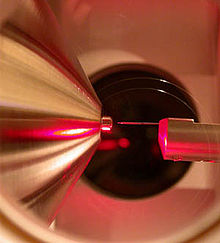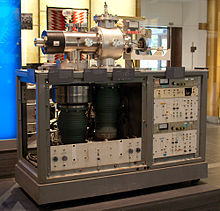- Electrospray ionization
-
Electrospray ionization (ESI) is a technique used in mass spectrometry to produce ions. It is especially useful in producing ions from macromolecules because it overcomes the propensity of these molecules to fragment when ionized. The development of electrospray ionization for the analysis of biological macromolecules[1] was rewarded with the attribution of the Nobel Prize in Chemistry to John Bennett Fenn in 2002.[2] One of the original instruments used by Dr. Fenn is on display at the Chemical Heritage Foundation in Philadelphia, Pennsylvania.
Mass spectrometry using ESI is called electrospray ionization mass spectrometry (ESI-MS) or, less commonly, electrospray mass spectrometry (ES-MS).
Contents
History
Early researchers:
Ionization mechanism
The liquid containing the analyte(s) of interest is dispersed by electrospray into a fine aerosol. Because the ion formation involves extensive solvent evaporation, the typical solvents for electrospray ionization are prepared by mixing water with volatile organic compounds (e.g. methanol, acetonitrile). To decrease the initial droplet size, compounds that increase the conductivity (e.g. acetic acid) are customarily added to the solution. Large-flow electrosprays can benefit from additional nebulization by an inert gas such as nitrogen. The aerosol is sampled into the first vacuum stage of a mass spectrometer through a capillary, which can be heated to aid further solvent evaporation from the charged droplets. The solvent evaporates from a charged droplet until it becomes unstable upon reaching its Rayleigh limit. At this point, the droplet deforms and emits charged jets in a process known as Coulomb fission. During the fission, the droplet loses a small percentage of its mass (1.0-2.3%) along with a relatively large percentage of its charge (10-18%).[6][7]
There are two major theories that explain the final production of gas-phase ions:
- The Ion Evaporation Model (IEM)[8] suggests that as the droplet reaches a certain radius the field strength at the surface of the droplet becomes large enough to assist the field desorption of solvated ions.
- The Charge Residue Model (CRM)[4] suggests that electrospray droplets undergo evaporation and fission cycles, eventually leading progeny droplets that contain on average one analyte ion or less. The gas-phase ions form after the remaining solvent molecules evaporate, leaving the analyte with the charges that the droplet carried.
While there is no definite scientific proof, a large body of indirect evidence suggests that small ions are liberated into the gas phase through the ion evaporation mechanism, while larger ions form by charged residue mechanism.
The ions observed by mass spectrometry may be quasimolecular ions created by the addition of a proton (a hydrogen ion) and denoted [M + H]+, or of another cation such as sodium ion, [M + Na]+, or the removal of a proton, [M − H]−. Multiply charged ions such as [M + nH]n+ are often observed. For large macromolecules, there can be many charge states, resulting in a characteristic charge state envelope. All these are even-electron ion species: electrons (alone) are not added or removed, unlike in some other ionization sources. The analytes are sometimes involved in electrochemical processes, leading to shifts of the corresponding peaks in the mass spectrum.
Variants
The electrosprays operated at low flow rates generate much smaller initial droplets, which ensure improved ionization efficiency. In 1994, two research groups coined the name micro-electrospray (microspray) for electrosprays working at low flow rates. Emmett and Caprioli demonstrated improved performance for HPLC-MS analyses when the electrospray was operated at 300-800 nL/min.[9] Wilm and Mann demonstrated that a capillary flow of ~ 25 nL/min can sustain an electrospray at the tip of emitters fabricated by pulling glass capillaries to a few micrometers.[10] The latter was renamed nano-electrospray (nanospray) in 1996.[11][12] Currently the name nanospray is also in use for electrosprays fed by pumps at low flow rates, not only for self-fed electrosprays. There are no well-defined flow rate ranges for electrospray, microspray, and nano-electrospray.
Applications
Electrospray is used to study protein folding [13][14][15]
Liquid chromatography–mass spectrometry (LC-MS)
Main article: liquid chromatography-mass spectrometryElectrospray ionization is the ion source of choice to couple liquid chromatography with mass spectrometry. The analysis can be performed online, by feeding the liquid eluting from the LC column directly to an electrospray, or offline, by collecting fractions to be later analyzed in a classical nanoelectrospray-mass spectrometry setup. The effect of various ion-pairing agents (such as TFA [16] on Electrospray-LCMS has been studied.
Noncovalent gas phase interactions
Electrospray ionization is also ideal in studying noncovalent gas phase interactions. The electrospray process is capable of transferring liquid-phase noncovalent complexes into the gas phase without disrupting the noncovalent interaction. This means that a cluster of two molecules can be studied in the gas phase by other mass spectrometry techniques. An interesting example of this is studying the interactions between enzymes and drugs which are inhibitors of the enzyme. Because inhibitors generally work by noncovalently binding to its target enzyme with reasonable affinity the noncovalent complex can be studied in this way. Competition studies between STAT6 and inhibitors [17][18] have been done in this way to screen for potential new drug candidates.[19]
See also
- Electrospray
- Protein mass spectrometry
- Taylor cone
- Desorption electrospray ionization
- Sonic spray ionization
References
- ^ Fenn, J. B.; Mann, M.; Meng, C. K.; Wong, S. F.; Whitehouse, C. M. (1989). "Electrospray ionization for mass spectrometry of large biomolecules". Science 246 (4926): 64–71. Bibcode 1989Sci...246...64F. doi:10.1126/science.2675315. PMID 2675315.
- ^ Markides, K; Gräslund, A. "Advanced information on the Nobel Prize in Chemistry 2002" (PDF). http://nobelprize.org/chemistry/laureates/2002/chemadv02.pdf.
- ^ Zeleny, J. (1914). "The Electrical Discharge from Liquid Points, and a Hydrostatic Method of Measuring the Electric Intensity at Their Surfaces". Physical Review 3 (2): 69. Bibcode 1914PhRv....3...69Z. doi:10.1103/PhysRev.3.69.
- ^ a b Dole, M.; Mack, L. L.; Hines, R. L.; Mobley, R. C.; Ferguson, L. D.; Alice, M. B. (1968). "Molecular Beams of Macroions". Journal of Chemical Physics 49 (5): 2240–2249. Bibcode 1968JChPh..49.2240D. doi:10.1063/1.1670391.
- ^ Alexandrov, M. L.; L. N. Gall, N. V. Krasnov, V. I. Nikolaev, V. A. Pavlenko, and V. A. Shkurov (1984). "Экстракция ионов из растворов при атмосферном давлении - Метод масс-спектрометрического анализа биоорганических веществ [Extraction of ions from solutions at atmospheric pressure - A method for mass spectrometric analysis of bioorganic substances]" (in Russian). Doklady Akademii Nauk SSSR 277 (2): 379–383. http://md1.csa.com/partners/viewrecord.php?collection=TRD&recid=N8524706AH.
- ^ Li, K.Y.; Tu, H.H.; Ray, A.K. (2005). "Charge Limits on Droplets during Evaporation". Langmuir 21 (9): 3786–3794. doi:10.1021/la047973n. PMID 15835938. http://pubs.acs.org/doi/abs/10.1021/la047973n.
- ^ Kebarle, P.; Verkerk, UH. (2009). "Electrospray: From ions in solution to ions in the gas phase, what we know now". Mass Spectrometry Reviews 28 (6): 898–917. doi:10.1002/mas.20247. PMID 19551695.
- ^ Iribarne J. V.; Thomson B. A. (1976). "On the evaporation of small ions from charged droplets". Journal of Chemical Physics 64 (6): 2287–2294. Bibcode 1976JChPh..64.2287I. doi:10.1063/1.432536.
- ^ Emmett MR, Caprioli RM (1994). "Micro-electrospray mass spectrometry: ultra-high-sensitivity analysis of peptides and proteins". J. Am. Soc. Mass Spectrom. 5 (7): 605–613. doi:10.1016/1044-0305(94)85001-1.
- ^ Wilm MS, Mann M (1994). "Electrospray and Taylor-Cone theory, Dole's beam of macromolecules at last?". Int. J. Mass Spectrom. Ion Proc. 136 (2-3): 167–180. Bibcode 1994IJMSI.136..167W. doi:10.1016/0168-1176(94)04024-9.
- ^ Wilm M, Mann M (1996). "Analytical properties of the nanoelectrospray ion source". Anal. Chem. 68 (1): 1–8. doi:10.1021/ac9509519. PMID 8779426.
- ^ Gibson et al. (2009), Mass Spectrometry Reviews 28 (6): 918–936, doi:10.1002/mas.20248
- ^ Konermann, L; Douglas, DJ (1998), "Equilibrium unfolding of proteins monitored by electrospray ionization mass spectrometry: Distinguishing two-state from multi-state transitions", Rapid Communications in Mass Spectrometry 12 (8): 435–442, doi:10.1002/(SICI)1097-0231(19980430)12:8<435::AID-RCM181>3.0.CO;2-F
- ^ Nemes et al. (2008), "Conformational and Noncovalent Complexation Changes in Proteins during Electrospray Ionization", Analytical Chemistry 80 (2): 387–395, doi:10.1021/ac0714359
- ^ Sobott; Robinson (2004), "Characterising electrosprayed biomolecules using tandem-MS—the noncovalent GroEL chaperonin assembly", International Journal of Mass Spectrometry 236 (1-3): 25–32, Bibcode 2004IJMSp.236...25S, doi:10.1016/j.ijms.2004.05.010
- ^ Garcia Journal of Chromatography B 825: 111-123, 2005
- ^ Touboul et al., JASMS 20: 303-311, 2009
- ^ Czuczy et al., JASMS 20:227-237, 2009 ; Jecklin et al., JASMS 19:332-343, 2008
- ^ Rosu et al., Biochimie 2008:1074-1087, 2008
Bibliography
- Cole, Richard (1997). Electrospray ionization mass spectrometry: fundamentals, instrumentation, and applications. New York: Wiley. ISBN 0-471-14564-5.
- Gross, Michael; Pramanik, Birendra N.; Ganguly, A. K. (2002). Applied electrospray mass spectrometry. New York, N.Y: Marcel Dekker. ISBN 0-8247-0618-8.
- Snyder, A. Peter (1996). Biochemical and biotechnological applications of electrospray ionization mass spectrometry. Columbus, OH: American Chemical Society. ISBN 0-8412-3378-0.
External links
- Electrospray Ionization Primer National High Magnetic Field Laboratory
- MeSH Electrospray+Ionization+Mass+Spectrometry
- New Objective: What is Electrospray?
Mass spectrometry Ion source Mass analyzer Detector MS combination Fragmentation Categories:
Wikimedia Foundation. 2010.


